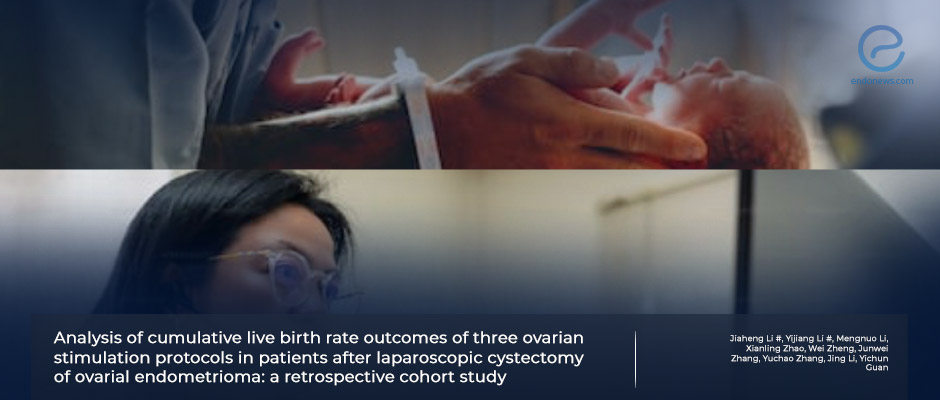Live Birth Rate for ovarian stimulation protocols after laparoscopic endometrioma cystectomy.
Oct 27, 2023
GnRH antagonist protocol and PPOS protocol can obtain better ovulation induction outcomes and cumulative live birth rate.
Key Points
Importance:
- The most appropriate controlled ovarian hyperstimulation protocol for the diminished ovarian reserve after laparoscopic surgery for ovarian cystectomy is not known.
Highlights:
- Laparoscopic cystectomy of ovarian endometrioma eliminates these ectopic lesions and restores the normal pelvic anatomy hence improving the quality of life.
- However, if the ovarian reserve is diminished, an individualized hyperstimulation protocol is necessary.
- GnRH antagonist protocol and PPOS protocol can obtain better ovulation induction outcomes and cumulative live birth rate.
What's done here:
- A Chinese author team studied 89 patients who received in vitro fertilization treatment or intracytoplasmic sperm injection (ICSI) between 2018-2020 who underwent laparoscopic cystectomy for ovarian endometriosis.
- The goal was to compare the effectiveness of different controlled ovarian hyperstimulation protocols.
- The patients were divided into 3 groups: Gn-releasing hormone (GnRH) antagonist group, a microstimulation group, and a progestin-primed ovarian stimulation (PPOS) group.
- This retrospective cohort study evaluated many outcomes, especially cumulative live birth rate, to find the proper stimulation of ovaries after surgery.
Key results:
- There were no significant differences in terms of total Gn dose, viable embryo, blastocyst formation, cumulative pregnancy, and live birth rates among the three groups.
- In the GnRH antagonist group, there were higher antral follicles, thicker endometrium on the hCG injection day, more retrieved oocytes, and higher embryo counts than the other two groups, but the starting dosage of gonadotropin was lower.
- The microstimulation protocol group had significantly higher oocyte output and embryo rates than the other two.
- The high-quality embryo rate was significantly higher in the progestin-primed ovarian stimulation protocol.
Lay Summary
The laparoscopic cystectomy of the ovaries is the first-line infertility treatment in patients with endometriomas. However, a possible diminished ovarian capacity after cystectomy with ovarian failure to respond to the gonadotropin stimuli seems an undesirable result of this procedure. Controlled ovarian hyperstimulation protocols may restore the cumulative pregnancy and life birth rate, and finding and applying the most appropriate protocol for these patients is of great interest.
GnRH antagonist, microstimulation, and progestin-primed ovarian stimulation protocols are the commonly used three protocols for this purpose. Li et al. from the Reproduction Center of The Third Affiliated Hospital of Zhengzhou University, China, retrospectively analyzed and compared the effects of these three protocols on the cumulative birth rate to determine the most appropriate procedure.
When the above procedures were compared, antral follicle count, the number of oocytes retrieved, and viable embryos were significantly higher in the GnRH antagonist group. The oocyte output rate was higher in the microstimulation protocol, whereas high-quality embryos were superior in the progestin-primed ovarian stimulation protocol. Overall, no statistical difference was obtained in cumulative pregnancy rate, cumulative live-birth rate, and blastocyst formation rate among these three protocols.
The authors found that the GnRH antagonist and progesterone-primed ovarian stimulation protocols have better ovulation induction outcomes and cumulative live birth rates for women aged under 40 than the microstimulation protocol in the case of postoperative preparation for artificial insemination. The endometrial receptivity is also superior in GnRH protocol, compared to others. For this reason, the authors concluded that whole embryo freezing followed by a frozen-thawed embryo transfer method to obtain more satisfactory induction protocols would be necessary. The comparative studies for assisted pregnancy outcomes in the context of economic costs would be the issue of future research.
This paper was recently published in journal named Reproductive Health.
Research Source: https://pubmed.ncbi.nlm.nih.gov/37644567/
laparoscopic cystectomy artificial insemination ovarian stimulation protocols GnRH antagonists live birth ratio ovarian endometriosis.

